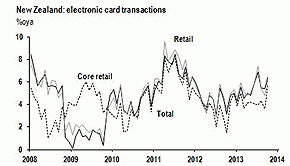
By Ben Jarman*
Following a September report which saw a steep, broad-based decline in sales (-0.9%m/m after revisions), retail card spending in New Zealand jumped back on track in October, increasing 1.4%m/m.
Further improvement will be required through 4Q to push retail spending back to the above-trend levels from earlier in the year, but the path of spending on a six month and annual basis still looks constructive (charts).
The recovery in October was concentrated in those categories which suffered the most damage in September, namely durables (+4.3%m/m after -3.2%m/m) and apparel (+3.1%m/m after -1.2%m/m).
While less impressive, the gain in the consumables category, which is mostly food and liquor retailing (+0.5%m/m) was the strongest since May. Adding in a respectable gain in hospitality sales (+0.5%m/m), core retail was up a frothy 1.8%m/m.
Outside of core retail, fuel also had a solid month (+4.5%m/m), coming back after a large fall (-2.5%m/m).
Aside from tracking consumer outlays, the card spending data are useful in providing a breakdown of how households are managing their finances between debit and credit facilities (cash sales are excluded here, but not in the more comprehensive quarterly retail report out later this week).
Today’s report shows credit card transactions increasing as a proportion of total spending, from 43.7% in September to 44.2% in October, though this is totally within the seasonal norms which see this proportion increase through the back half of the year.
With use of revolving credit still range-y, and credit growth fading, but the saving rate having stalled in its required ascent, the response of the household sector to rising dwelling prices is somewhat mixed so far.
If forced to make a call however, the fact that the uplift in consumer spending this year is being matched by an income impulse from hiring, and that households are not loosening the purse-strings beyond what those income fundamentals would allow, probably is sufficient evidence for the RBNZ that housing strength is not yet leading to an inefficient allocation of resources.
With the economy seemingly operating on a fairly benign growth/inflation trade-off for now, the RBNZ can sit on the sideline for a little while to see how LVR restrictions play out.
Electronic transactions
Select chart tabs
-------------------------------------------------------------------------------
Ben Jarman is an economist at JP Morgan Australia, Sydney.
1 Comments
In other words the NZ domestic economy, consumer activity and household spending and attitude is still ..... if not depressed then pretty flat-line.
Watch what happens upon the first "rate hike". Less consumer spending and retrenched household spending.
Banks are getting anxious as well - no rate hikes for 4 years. And now decreased lending. Still healthy margins giving them current healthy profits. Next year not looking so good.
We welcome your comments below. If you are not already registered, please register to comment.
Remember we welcome robust, respectful and insightful debate. We don't welcome abusive or defamatory comments and will de-register those repeatedly making such comments. Our current comment policy is here.